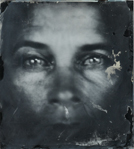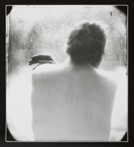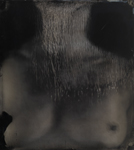How do you change the image of an artist?
John Ravenal, the the curator of modern and contemporary art at the Virginia Museum of Fine Arts, set that goal for his next exhibition — “Sally Mann: The Flesh and The Spirit,” which opens on Saturday, in the museum’s new wing. I did a short item on the show for the November issue of The Art Newspaper, but let me elaborate here.
 “I want people to take a new look at Sally’s photography, and think of her as one of our foremost contemporary artists, not just one of our foremost photographers,” Ravenal told me.
“I want people to take a new look at Sally’s photography, and think of her as one of our foremost contemporary artists, not just one of our foremost photographers,” Ravenal told me.
Mann has had something of a problem since she burst onto the global art scene in the early 1990s with her “Immediate Family” photographs. They revealed her children, often naked, in provocative poses – and they shocked the world. “People, when they hear ‘Sally Mann,’ ” Ravenal says, “they immediately think of ‘Immediate Family,’ and they think they know her work, and they have already formed an opinion of her and her work.”
 Perhaps that’s why, when Ravenal approached her with the idea of doing a retrospective, Mann said no (she said it would constrain her creativity). Instead, Ravenal’s exhibition, which contains about 100 works, includes nothing from “Immediate Family.” It displays newer work, including her first foray into self-portraits and photographs that focus on her husband, who suffers from a degenerative muscle disease. It takes the body, often portrayed naked and in close-up, abstract images, as its theme. The works address aging, mortality and decay, literally and metaphorically. Ravenal also included never-before-shown still lifes that have a fleshy quality and landscapes of Civil War battlefields, sites of massive human deaths.
Perhaps that’s why, when Ravenal approached her with the idea of doing a retrospective, Mann said no (she said it would constrain her creativity). Instead, Ravenal’s exhibition, which contains about 100 works, includes nothing from “Immediate Family.” It displays newer work, including her first foray into self-portraits and photographs that focus on her husband, who suffers from a degenerative muscle disease. It takes the body, often portrayed naked and in close-up, abstract images, as its theme. The works address aging, mortality and decay, literally and metaphorically. Ravenal also included never-before-shown still lifes that have a fleshy quality and landscapes of Civil War battlefields, sites of massive human deaths.
 The bulk of the show is more literal, though. Ever fearless, for her “Body Farm” series, Mann traveled to the University of Tennessee Forensic Anthropology Center, famed for its advanced methods of identifying skeletal, badly decomposed, or otherwise unidentified human remains. In other works, she explores her own face, neck and naked chest (samples here). Two self-portrait pieces line up multiple unique photographs printed on black glass–a format known as ambrotypes– to form monumental grids of her likeness. And to expose an area of Mann’s work most people are unaware of – color photography – Ravenal has drawn works from three color series, including “Family Color,” images of her children akin to those that made Mann famous.
The bulk of the show is more literal, though. Ever fearless, for her “Body Farm” series, Mann traveled to the University of Tennessee Forensic Anthropology Center, famed for its advanced methods of identifying skeletal, badly decomposed, or otherwise unidentified human remains. In other works, she explores her own face, neck and naked chest (samples here). Two self-portrait pieces line up multiple unique photographs printed on black glass–a format known as ambrotypes– to form monumental grids of her likeness. And to expose an area of Mann’s work most people are unaware of – color photography – Ravenal has drawn works from three color series, including “Family Color,” images of her children akin to those that made Mann famous.
“It will be eye-opening,” Ravenal says.
But will it be enough to lift Mann’s reputation? Hard to say, as the show — which is quite expensive — will not travel. There is an exhibition catalogue, however, published by Aperture, which includes some works that are not on display.
Photo Credits: Courtesy of VMFA
